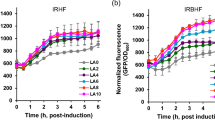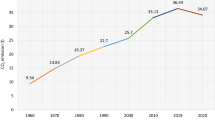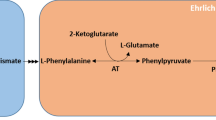Abstract
Lactobacillus reuteri grown in MRS broth containing 20 mM glycerol exhibits 3.7-fold up-regulation of 3-hydroxypropionic acid (3-HP) pathway genes during the stationary phase. Concomitantly, the resting cells prepared from stationary phase show enhancement in bio-conversion of glycerol, and the maximum specific productivity (q p) is found to be 0.17 g 3-HP per g CDW per hour. The regulatory elements such as catabolite repression site in the up-stream of 3-HP pathway genes are presumed for the augmentation of glycerol bio-conversion selectively in stationary phase. However, in the repression mutant, the maximum q p of 3-HP persisted in the stationary phase-derived resting cells indicating the role of further regulatory features. In the production stage, the external 3-HP concentration of 35 mM inhibits 3-HP synthesis. In addition, it has also moderated 1,3-propanediol formation, as it is a redox bio-catalysis involving NAD+/NADH ratio of 6.5. Repeated batch bio-transformation has been used to overcome product inhibition, and the total yield (Ypx) of 3-HP from the stationary phase-derived biomass is 3.3 times higher than that from the non-repeated mode. With the use of appropriate gene expression condition and repeated transfer of biomass, 3-HP produced in this study can be used for low-volume, high-value applications.




Similar content being viewed by others
References
Zhou YJ, Yang W, Wang L et al (2013) Engineering NAD+ availability for Escherichia coli whole-cell biocatalysis: a case study for dihydroxyacetone production. Microb Cell Fact 12:103. doi:10.1186/1475-2859-12-103
Julsing MK, Kuhn D, Schmid A, Bühler B (2012) Resting cells of recombinant E. coli show high epoxidation yields on energy source and high sensitivity to product inhibition. Biotechnol Bioeng 109:1109–1119. doi:10.1002/bit.24404
Khan A, Bhide A, Gadre R (2009) Mannitol production from glycerol by resting cells of Candida magnoliae. Bioresour Technol 100:4911–4913. doi:10.1016/j.biortech.2009.04.048
O’Brien DJ, Panzer CC, Eisele WP (1990) Biological production of acrylic acid from cheese whey by resting cells of Clostridium propionicum. Biotechnol Prog 6:237–242. doi:10.1021/bp00004a001
Zhang Y, Song L, Gao Q et al (2012) The two-step biotransformation of monosodium glutamate to GABA by Lactobacillus brevis growing and resting cells. Appl Microbiol Biotechnol 94:1619–1627. doi:10.1007/s00253-012-3868-8
Borodina I, Kildegaard KR, Jensen NB et al (2015) Establishing a synthetic pathway for high-level production of 3-hydroxypropionic acid in Saccharomyces cerevisiae via β-alanine. Metab Eng 27:57–64. doi:10.1016/j.ymben.2014.10.003
Kumar V, Ashok S, Park S (2013) Recent advances in biological production of 3-hydroxypropionic acid. Biotechnol Adv 31:945–961. doi:10.1016/j.biotechadv.2013.02.008
Kumar V, Sankaranarayanan M, Durgapal M et al (2013) Simultaneous production of 3-hydroxypropionic acid and 1,3-propanediol from glycerol using resting cells of the lactate dehydrogenase-deficient recombinant Klebsiella pneumoniae overexpressing an aldehyde dehydrogenase. Bioresour Technol 135:555–563. doi:10.1016/j.biortech.2012.11.018
Kumar V, Sankaranarayanan M, Jae K-E et al (2012) Co-production of 3-hydroxypropionic acid and 1,3-propanediol from glycerol using resting cells of recombinant Klebsiella pneumoniae J2B strain overexpressing aldehyde dehydrogenase. Appl Microbiol Biotechnol 96:373–383. doi:10.1007/s00253-012-4187-9
Sankaranarayanan M, Ashok S, Park S (2014) Production of 3-hydroxypropionic acid from glycerol by acid tolerant Escherichia coli. J Ind Microbiol Biotechnol 41:1039–1050. doi:10.1007/s10295-014-1451-2
Jiang X, Meng X, Xian M (2009) Biosynthetic pathways for 3-hydroxypropionic acid production. Appl Microbiol Biotechnol 82:995–1003. doi:10.1007/s00253-009-1898-7
Sebastianes FLS, Cabedo N, El Aouad N et al (2012) 3-Hydroxypropionic acid as an antibacterial agent from endophytic fungi Diaporthe phaseolorum. Curr Microbiol 65:622–632. doi:10.1007/s00284-012-0206-4
Krauter H, Willke T, Vorlop K-D (2012) Production of high amounts of 3-hydroxypropionaldehyde from glycerol by Lactobacillus reuteri with strongly increased biocatalyst lifetime and productivity. New Biotechnol 29:211–217. doi:10.1016/j.nbt.2011.06.015
Lee S-O, Hong G-W, Oh D-K (2003) Bioconversion of linoleic acid into conjugated linoleic acid by immobilized Lactobacillus reuteri. Biotechnol Prog 19:1081–1084. doi:10.1021/bp0257933
Morita H, Toh H, Fukuda S et al (2008) Comparative genome analysis of Lactobacillus reuteri and Lactobacillus fermentum reveal a genomic island for reuterin and cobalamin production. DNA Res 15:151–161. doi:10.1093/dnares/dsn009
Van Maris AJA, Konings WN, Van Dijken JP, Pronk JT (2004) Microbial export of lactic and 3-hydroxypropanoic acid: implications for industrial fermentation processes. Metab Eng 6:245–255. doi:10.1016/j.ymben.2004.05.001
Sriramulu DD, Liang M, Hernandez-Romero D et al (2008) Lactobacillus reuteri DSM 20016 produces cobalamin-dependent diol dehydratase in metabolosomes and metabolizes 1,2-propanediol by disproportionation. J Bacteriol 190:4559–4567. doi:10.1128/JB.01535-07
Santos F, Spinler JK, Saulnier DMA et al (2011) Functional identification in Lactobacillus reuteri of a PocR-like transcription factor regulating glycerol utilization and vitamin B12 synthesis. Microb Cell Fact 10:55. doi:10.1186/1475-2859-10-55
Dishisha T, Pereyra LP, Pyo S-H et al (2014) Flux analysis of the Lactobacillus reuteri propanediol-utilization pathway for production of 3-hydroxypropionaldehyde, 3-hydroxypropionic acid and 1,3-propanediol from glycerol. Microb Cell Fact 13:76. doi:10.1186/1475-2859-13-76
Sabet-Azad R, Linares-Pastén JA, Torkelson L et al (2013) Coenzyme A-acylating propionaldehyde dehydrogenase (PduP) from Lactobacillus reuteri: kinetic characterization and molecular modeling. Enzym Microb Technol 53:235–242. doi:10.1016/j.enzmictec.2013.05.007
Vaidyanathan H, Kandasamy V, Gopal Ramakrishnan G et al (2011) Glycerol conversion to 1, 3-Propanediol is enhanced by the expression of a heterologous alcohol dehydrogenase gene in Lactobacillus reuteri. AMB Express 1:37. doi:10.1186/2191-0855-1-37
Kandasamy V, Vaidyanathan H, Djurdjevic I et al (2013) Engineering Escherichia coli with acrylate pathway genes for propionic acid synthesis and its impact on mixed-acid fermentation. Appl Microbiol Biotechnol 97:1191–1200. doi:10.1007/s00253-012-4274-y
Hufner E, Britton RA, Roos S et al (2008) Global transcriptional response of Lactobacillus reuteri to the sourdough environment. Syst Appl Microbiol 31:323–338. doi:10.1016/j.syapm.2008.06.005
Ji X-J, Xia Z-F, Fu N-H et al (2013) Cofactor engineering through heterologous expression of an NADH oxidase and its impact on metabolic flux redistribution in Klebsiella pneumoniae. Biotechnol Biofuels 6:7. doi:10.1186/1754-6834-6-7
Zhu C-T, Rand DM (2012) A hydrazine coupled cycling assay validates the decrease in redox ratio under starvation in Drosophila. PLoS One 7:e47584. doi:10.1371/journal.pone.0047584
Chen G, Chen J (2013) A novel cell modification method used in biotransformation of glycerol to 3-HPA by Lactobacillus reuteri. Appl Microbiol Biotechnol 97:4325–4332. doi:10.1007/s00253-013-4723-2
Zamudio-Jaramillo MA, Hernandez-Mendoza A, Robles VJ et al (2009) Reuterin production by Lactobacillus reuteri NRRL B-14171 immobilized in alginate. J Chem Technol Biotechnol 84:100–105. doi:10.1002/jctb.2012
Ragout A, Siñeriz F, Diekmann H, de Valdez GF (1996) Shifts in the fermentation balance of Lactobacillus reuteri. In the presence of glycerol. Biotechnol Lett 18:1105–1108. doi:10.1007/BF00129740
Ashok S, Mohan Raj S, Ko Y et al (2013) Effect of puuC overexpression and nitrate addition on glycerol metabolism and anaerobic 3-hydroxypropionic acid production in recombinant Klebsiella pneumoniae ΔglpKΔdhaT. Metab Eng 15:10–24. doi:10.1016/j.ymben.2012.09.004
Strough M (2013) The role of bacterial micro-compartments in the fermentation of D-arabinose in Clostridium phytofermentans. Dissertation, University of Massachusetts, Amherst
Erbilgin O, McDonald K, Kerfeld C (2014) Characterization of a planctomycetal organelle: a novel bacterial microcompartment for the aerobic degradation of plant saccharides. Appl Environ Microbiol 80:2193–2205. doi:10.1128/AEM.03887-13
Kim EY, Jakobson CM, Tullman-Ercek D (2014) Engineering transcriptional regulation to control Pdu microcompartment formation. PLoS One 9:e113814. doi:10.1371/journal.pone.0113814
Wall T, Båth K, Britton RA et al (2007) The early response to acid shock in Lactobacillus reuteri involves the ClpL chaperone and a putative cell wall-altering esterase. Appl Environ Microbiol 73:3924–3935. doi:10.1128/AEM.01502-06
El-Ziney MG, Arneborg N, Uyttendaele M et al (1998) Characterization of growth and metabolite production of Lactobacillus reuteri during glucose/glycerol cofermentation in batch and continuous cultures. Biotechnol Lett 20:913–916. doi:10.1023/A:1005483215378
Gopi GR, Ganesh N, Pandiaraj S, Sowmiya B et al (2015) A Study on enhanced expression of 3-hydroxypropionic acid pathway genes and impact on its production in Lactobacillus reuteri. Food Technol Biotechnol. doi:10.17113/ftb.53.03.15.3976
Talarico TL, Axelsson LT, Novotny J et al (1990) Utilization of glycerol as a hydrogen acceptor by Lactobacillus reuteri: purification of 1,3-propanediol: NAD oxidoreductase. Appl Environ Microbiol 56:943–948
Stevens MJ, Vollenweider S, Meile L, Lacroix C (2011) 1,3-Propanediol dehydrogenases in Lactobacillus reuteri: impact on central metabolism and 3-hydroxypropionaldehyde production. Microb Cell Fact 10:61. doi:10.1186/1475-2859-10-61
Flamholz A, Noor E, Bar-Even A, Milo R (2012) eQuilibrator—the biochemical thermodynamics calculator. Nucl Acids Res 40:D770–D775. doi:10.1093/nar/gkr874
De Lorenzo V (2015) It’s the metabolism, stupid! Environ Microbiol Rep 7:18–19. doi:10.1111/1758-2229.12223
Noor E, Bar-Even A, Flamholz A et al (2014) Pathway thermodynamics highlights kinetic obstacles in central metabolism. PLoS Comput Biol 10:e1003483. doi:10.1371/journal.pcbi.1003483
Van Pijkeren J-P, Neoh KM, Sirias D et al (2012) Exploring optimization parameters to increase ssDNA recombineering in Lactococcus lactis and Lactobacillus reuteri. Bioengineered 3:209–217. doi:10.4161/bioe.21049
Acknowledgments
The first author is thankful to Council of Scientific and Industrial Research (CSIR), India, for the senior research fellowship. The research work was supported by UGC MRP grant, Gov. of India.
Author information
Authors and Affiliations
Corresponding author
Electronic supplementary material
Below is the link to the electronic supplementary material.
Rights and permissions
About this article
Cite this article
Gopal Ramakrishnan, G., Nehru, G., Suppuram, P. et al. Bio-transformation of Glycerol to 3-Hydroxypropionic Acid Using Resting Cells of Lactobacillus reuteri . Curr Microbiol 71, 517–523 (2015). https://doi.org/10.1007/s00284-015-0878-7
Received:
Accepted:
Published:
Issue Date:
DOI: https://doi.org/10.1007/s00284-015-0878-7




